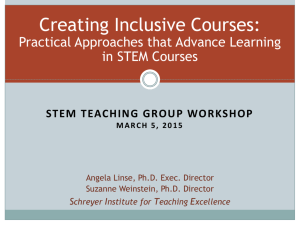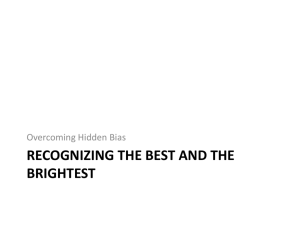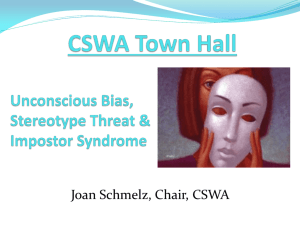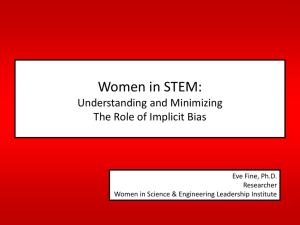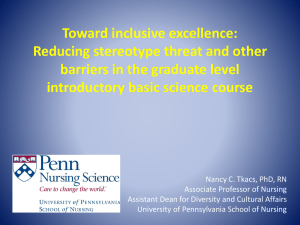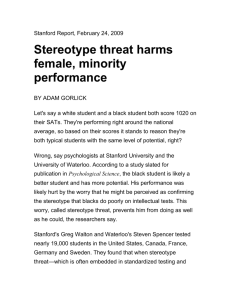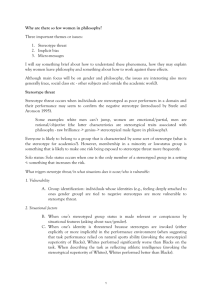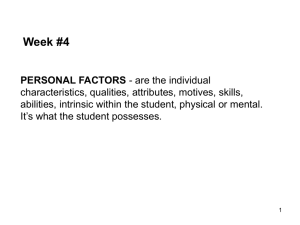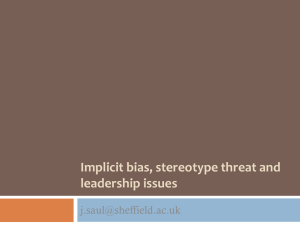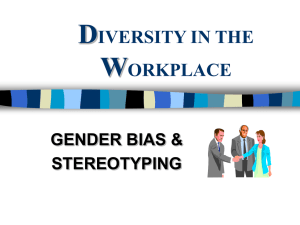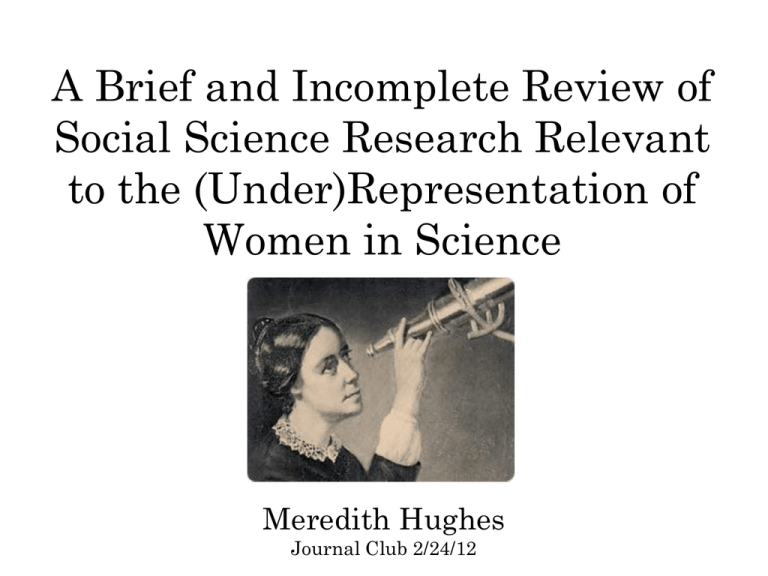
A Brief and Incomplete Review of
Social Science Research Relevant
to the (Under)Representation of
Women in Science
Meredith Hughes
Journal Club 2/24/12
Disclaimers
• 1) I am not a social scientist
• 2) Most of what I am planning to say will
be old news to people already in the know
• 3) This is an incredibly complicated issue
• 4) The underrepresentation of racial/ethnic
minorities is also a worthy discussion
topic, but the issues are different and an
order of magnitude larger
• 5) The purpose of this talk is awareness,
not finger-pointing
My Assumptions
• Men and women are equally capable of
making valuable scientific contributions
(e.g., Spelke 2005 review, “The Mathematics of Sex” by Ceci & Williams
2010, Mertz & Kane 2012)
– Neither interest (Xie & Shauman 2003) nor persistence
(Seymour & Hewitt 1990s) is correlated with ability.
When women leave, we lose talent.
• Diversity (of people, experience,
opinions) contributes to innovation and
excellence (e.g., “The Difference,” by Scott Page)
Outline
• Good news, bad news – the status of
women in STEM/astronomy
• Sociological barriers and what to do
about them
– Implicit Bias
– Stereotype Threat
– Imposter Syndrome
• Cultural barriers and what to do about
them
The Good News
• Things are a lot better than they used to be.
“Not until 1965 did a woman legally observe at the
Hale Observatories” – Vera Rubin, Science, 1981
Margaret Burbidge
The Good News
• As of 2003, the only statistically significant "leak" in the
astronomy pipeline was at the bachelors-to-PhD transition
(Ivie 2003), although there is some evidence that
representation at the upper levels may be stagnating with
time (Hoffman & Urry 2004)
Ivie & Ray
AIP report 2005
The Good News
• As of 2003, there is no trend in gender representation with
institution size or prestige as determined by NRC ranking
(Hoffman & Kwitter 2003).
• Institutions with >25% tenured female faculty in
astronomy as of 2011 (source: CSWA website):
* U. Wisconsin
* Caltech
* Yale U.
* CWRU
* NM Tech
* U. Washington
* Indiana University
* Gemini Observatories
The Good News
• Across all STEM fields (except mathematics), women who
obtain faculty jobs are promoted and retained at
approximately the same rates as men (Kaminski & Geisler 2012,
Science)
The Bad News
• Across all STEM fields (except mathematics), women who
obtain faculty jobs are promoted and retained at
approximately the same rates as men (Kaminski & Geisler 2012,
Science)
• BUT
– There is a 24% gap in the tenure rate between men (77%) and
women (53%) who became parents within 5 years of PhD
– 50% of tenured women in science, but only 30% of men, are childless
14 years after receiving their PhD
– Tenured women are twice as likely as tenured men to be single
(Mason & Gouldin 2002)
The Bad News
• Women opt out of STEM careers at much higher rates than
men before the faculty level. When men opt out, salary is
the most highly cited reason, whereas women cite more
interpersonal, cultural, and family reasons. (Preston 2004)
The Bad News
• There are enormous variations between astronomy
institutions, more so than can be accounted for by small
number statistics (see CSWA website for up-to-date
statistics). Allow me to point to a provocative, close-tohome example.
Berkeley’s fraction of female astro
postdocs over the last 10 years is
consistently lower than
• Other top-tier institutions
• Prize fellowships (20-yr average)
• National average PhD recipients
2010
(5/35) now
(3/26)
Figure courtesy M. Modjaz
The Bad News
• There is a large body of research documenting systematic,
widely-held biases and beliefs held by all people that
disadvantage women pursuing scientific careers. (I'll
discuss a few of these.)
Sociological Barriers and What to
Do About Them
xkcd.com/385
Unconscious Bias
The idea: we ALL (men and women) unconsciously
devalue the contributions of women (even when it
conflicts with our conscious beliefs).
Gender schemas (see Valian 1998), like many other
heuristics, are designed to help our brains make
decisions under pressure/stress/ambiguity (not to be fair)
Please take an implicit bias test (preferably including
the one on women in science):
implicit.harvard.edu
http://earthobservatory.nasa.gov/blogs/earthmatters/2011/07/12/
Some data…
• Classic study: Steinpreis, Anders & Ritzke (1999)
– Panels of male and female university psych professors were
asked to evaluate identical application packages for assistant
professors: “Brian” or “Karen”
– 2:1 preference for Brian over Karen
– When evaluating tenure promotion cases, panel members
expressed reservations four times more often when the name
was female (effect stronger with seniority)
– Argument for having explicit hiring criteria before a search
• Side note: PTA bias (Correll, Benard & Paik 2007)
– Identical CVs except for one line: “Active on the PTA”
– Prospective employers called mothers back half as often
– Fathers offered higher starting salaries
Swedish Medical Research
Council Postdocs
• ‘Competence’ assigned by a
reviewer
• ‘Impact’ numerically assessed
(total publications, 1st author,
citations, journal impact)
• Only the women with impact
scores >100 were peer-reviewed
to be as competent as any of the
groups of men
Reviewers should question their
assessment of a candidate’s
“competence,” use objective
measures
Wenneras & Wold (1997)
Aspects of the Application Process
Particularly Susceptible to Bias
• Evaluators give systematically lower scores to women
when under time pressure (Martell 1991)
– Spend at least 5 minutes on each application
• When only one person is chosen to represent “the best”
example of a field, they usually fit the stereotype. If many
are chosen, diversity is represented (Purdie et al. studies)
– Cluster hiring when possible
• Increasing the representation of a minority in the
applicant pool reduces the use of schemas (Sackett et al. 1991)
– Actively recruit a diverse applicant pool
Aspects of the Application Process
Particularly Susceptible to Bias
• Recommendation letters (Hebl, Martin, Madera 2009)
– 194 applications for 8 junior faculty positions at a US university
– Names and gendered pronouns removed
– Letter writers conform to traditional gender schemas, use more
“communal” language for women (more “agentic” for men)
– No difference between objective measures of ability (total
publications, first author publications, citations, journal impact
factor)
– Communal characteristics are less valued by application
reviewers
• Also (Trix & Penska 2003): length, doubt, specificity,
superlatives vs. “grindstone” adjectives, personality/family
• Keep an eye out for gendered language in recommendation
letters; question letter-writers’ evaluation of candidate
(and think about it when you’re writing letters too)
Recap: Some strategies for
counteracting implicit bias
• Use pre-defined, explicit, quantifiable hiring
criteria whenever possible
• Try to spend more time on each application
• Cluster hiring
• Watch for gendered language in
recommendation letters (your own and others’)
• Actively recruit a diverse applicant pool (a
diverse committee helps too)
• Maintain awareness
Stereotype Threat
The idea: Stereotype threat refers to “being at risk of
confirming, as self-characteristic, a negative stereotype of
one’s group” (Steele & Aronson 1995) – originally studied in the
context of racial minorities, now over 300 peer-reviewed
studies in a variety of circumstances.
Great resource: reducingstereotypethreat.org
A couple of experiments…
• Male and female students in the last semester of an
advanced calculus sequence were given a practice
test of GRE-level problems (Good, Aronson, Harder 2008)
– All students were told that the test was “aimed at
measuring your mathematical ability” – men
outperform women
– Half the students were told “this mathematics test has
not shown any gender differences in performance or
mathematics ability” – no gender gap for that case.
• Asian women do better when reminded of their race
and worse when reminded of their gender at the
beginning of a math test (Shih, Pittinsky, Ambardy 1999)
• An explanation for the 15% gender gap on the
physics GRE?
More about Stereotype Threat
Stereotype threat has many consequences for minorities:
• Underachievement on academic tasks
• Self-handicapping strategies (e.g., reduced practiced
time) (Stone 2002)
• Reduced value placed on domain (e.g., Aronson et al. 2002)
• Limit range of professions, leading to educational and
social inequality (e.g., Good et al. 2008)
Read application packages with an awareness that
academic achievement and interest may be affected by
stereotype threat
Ways to reduce stereotype threat
• Really simple: move standard demographic inquiries
to the end of a test (Danaher & Crandall 2008) (estimated 4700
additional students annually would receive AP calculus credit)
• Encourage students to think of themselves in ways
that reduce salience of threatened identity (example:
values affirmation writing exercise in CU Boulder physics class raised
women’s grades by a full letter on average) (Miyake et al. 2010)
• Constructive feedback: set high standards but express
assurance that student can meet them (Cohen, Steele &
Ross 1999)
• Make role models visible (Marx, Stapel, Muller 2005)
• Evaluate standardized test scores in context
Imposter Syndrome (or “Phenomenon”)
• This is not news. The term was coined by Clance & Imes
(1978), and IS has been around since the beginning of time
(or at least universities)
• Clarence IP inventory sample:
– I can give the impression that I’m more confident than I really am
– When people praise me for something, I’m afraid I won’t be able to
live up to their expectations for me in the future
– I’m afraid people important to me may find out I’m not as capable
as I think I am
– At times, I feel my success is due to some kind of luck
– When I have succeeded at something, I have doubts that I can keep
repeating that success
Strategies for mitigating IS
• Suggestions for advisors:
– Give honest and regular feedback
– Give students a sense of the importance of
their work
– Set students up for small confidencebuilding successes
– Be open about stress, IS, your own failures
– Give regular encouragement
Adapted from “Beating the Imposter Syndrome” by Margot Gerritson
Cultural Barriers and What to Do
about Them
Do Babies (or Families) Matter?
• Yes and no.
• No:
– Childless women are not more successful (Mason & Gouldin 2002)
– There are many women in other demanding fields
– Academic careers are relatively flexible (see Urry 2009)
• Yes:
– 68% of married female physicists are married to
scientists, while only 17% of married male physicists are
(McNeil & Sher 1999)
– Once a woman has children she is less likely to pursue a
career in science, move, be promoted, be employed (Xie &
Shauman 2003)
– Tenure gap (Mason & Gouldin 2002)
– Ladder-rank faculty in UC system (Mason & Gouldin 2004):
women spend on average 4.5 hours/week less on
professional work, 18 hours more on housework/childcare
– The PTA bias (Correll, Benard & Paik 2007)
Parenting attitudes among
college physics students
Urry 2009 in Status – informal survey of introductory physics students at Yale University
What can departments do?
• It is difficult to address these issues, because to
some extent the solutions will be individual.
• A lot of ink has been spilled about
university/faculty-level strategies (see, e.g., Clayman Institute
@ Stanford, UC Irvine ADVANCE program)
• Mentoring, awareness (resources on CSWA website)
• Make policies transparent and easy to find
• Postdoc level: extra years of support (reduce need to
move)
• Grad/postdoc level: support for paid parental leave,
G-clock extensions, childcare
• Grad/postdoc level: allowance for family-related
gaps in application evaluations
• What else can we think of?
Parting thoughts…
• The strategies that I’ve listed, for the most
part, help everyone.
• The key to addressing many of these issues
is awareness. Let’s keep talking about
them.
• I will post this talk on the web, along with
some additional resources I found helpful
while preparing it
• If you want to keep up with these issues,
consider joining the AASWOMEN list.
Resources on the Web
• CSWA website (particularly the “Resources” page):
http://www.aas.org/cswa/
• Reducing Stereotype Threat:
http://reducingstereotypethreat.org/
• Implicit bias website: http://implicit.harvard.edu
• Kathryn Johnston’s talk (archived on CfA WIS web page):
http://www.cfa.harvard.edu/cfawis/kathryn_johnston.pdf
• Paul’s Ethics for Astronomers lecture archives:
http://astro.berkeley.edu/~kalas/ethics/pages/lectures.html
• Meg Urry’s Women in Science talks:
http://pantheon.yale.edu/~cmu2/

